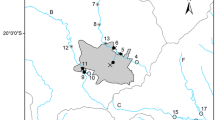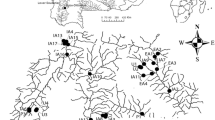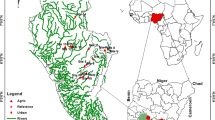Abstract
The study evaluated the response of macroinvertebrate assemblages to changes in water quality in different land-use settings in Manyame catchment, Zimbabwe. Four land-use categories were identified: forested commercial farming, communal farming, Great Dyke mining (GDM) and urban areas. Macroinvertebrate community structure and physicochemical variables data were collected in two seasons from 41 sites following standard methods. Although not environmentally threatening, urban and GDM areas were characterised by higher conductivity, total dissolved solids, salinity, magnesium and hardness. Chlorides, total phosphates, total nitrogen, calcium, potassium and sodium were significantly highest in urban sites whilst dissolved oxygen (DO) was significantly higher in the forested commercial faming and GDM sites. Macroinvertebrate communities followed the observed changes in water quality. Macroinvertebrates in urban sites indicated severe pollution (e.g. Chironomidae) whilst those in forested commercial farming sites and GDM sites indicated relatively clean water (e.g. Notonemouridae). Forested watersheds together with good farm management practices are important in mitigating impacts of urbanisation and agriculture. Strategies that reduce oxygen-depleting substances must be devised to protect the health of Zimbabwean streams. The study affirms the wider applicability of the South African Scoring System in different land uses.


Similar content being viewed by others
References
American Water Works Association (AWWA) (1990) Water quality and treatment, a handbook of community water supply, 4th edn. McGraw-hill, Inc, New York
APHA (1988) Standard methods for the examination of water and waste water, 20th edn. American Public Health association, Washington
Bere T, Mangadze T (2014) Diatom communities in streams draining urban areas: community structure in relation to environmental variables. J Trop Ecol 55(2):271–281
Bere T, Nyamupingidza B (2014) Use of biological monitoring tools beyond their country of origin: a case study of the South African Scoring System Version 5 (SASS5). Hydrobiologia 722:223–232
Bernhardt ES, Lutz BD, King RS, Fay JP, Carter CE, Helton AM, Campagna D, Amos J (2012) How many mountains can we mine? Assessing the regional degradation of Central Appalachian rivers by surface coal mining. Environ Sci Technol 46:8115–8122
Broussard W, Turner RE (2009) A century of changing land-use and water-quality relationships in the continental US. Front Ecol Environ 7(6):302–307
Calow P, Petts GE (1994) The rivers handbook, vol 2. Blackwell Scientific Publications, Oxford
Chapman D (1996) Water quality assessments, a guide to the use of biota, sediments and water in environmental monitoring, 2nd edn. E&FN SPON, London
Chuan MC, Shu GY, Liu JC (1996) Solubility of heavy metals in a contaminated soil: effects of redox potential and pH. Water Air Soil Pollut 90:543–556
Connollym NM, Crossland R, Pearson RG (2004) Effect of low dissolved oxygen on survival, emergence, and drift of tropical stream macroinvertebrates. J N Am Benthol Soc 23(2):251–270
Cormier SM, Suter GW, Zheng L, Pond GJ (2013a) Assessing causation of the extirpation of stream macroinvertebrates by a mixture of ions. Environ Toxicol Chem 32:277–287
Cormier SM, Suter GW, Zheng L (2013b) Derivation of a benchmark for freshwater ionic strength. Environ Toxicol Chem 32:263–271
Dickens CWS, Graham PM (2002) The South African Scoring System (SASS) Version 5 rapid bioassessment method for rivers. Afr J Aquat Sci 27(1):1–10
Dube D, Swatuk LA (2002) Stakeholder participation in the new water management approach: a case study of the Save catchment, Zimbabwe. Phys Chem Earth Parts A/B/C 27(11):867–874
Garland A, Herzer L (2009) Water for the urban poor: integrated solution. SAIS Rev Int Aff 29(1):101–107
Gauch HG (1982) Multivariate analysis in community ecology. Cambridge University Press, New York
Geber A, Gabriel MJM (2002) Aquatic invertebrates of South African rivers field guide. Institute of water quality studies, Pretoria
Gooderham J, Tsyrlin E (2002) The water bug book: a guide to the freshwater macroinvertebrates of temperate Australia. CSIRO Publishing, Collingwood Vic. doi:10.1046/j.1440-6055.2003.00323.x
Gratwicke B (1998) The effect of season on a biotic water quality index: a case study of the Yellow Jacket and Mazowe rivers, Zimbabwe. South Afr J Aquat Sci 24(1-2):24–35
Gumindoga W, Rientjes T, Shekede MD, Rwasoka DT, Nhapi I, Haile AT (2014) Hydrological impacts of urbanization of two catchments in Harare, Zimbabwe. Remote Sens 6(12):12544–12574
Hammer O, Harper DAT, Ryan PD (2012) PAST – Palaeontological Statistics, Version 1.90. http://folk.uio.no/ohammer/past. Accessed 23 Feb 2013
Hamzaoui D, Arab A (2012) Water quarter quality and macroinvertebrates community structure along a Saharan stream: The Saoura Wadi (ALGERIA) Sixteenth International Water Technology Conference. IWTC 16 2012, Istanbul
Irwin EG, Bockstael NE (2006) The spatial pattern of land use in the U.S. In: Arnott R, McMillen D (eds) A companion to urban economics. Blackwell, pp 77–95.
Jirka AM, Carter MJ (1975) Micro-semi-automated analysis of surface and waste waters for chemical oxygen demand. Anal Chem 47:1397
Johnson DL, Ambrose S, Bassett T, Bowen M, Crummey D, Isaacson J, Johnson DN, Lamb P, Saul M, Winter-Nelson A (1997) Meanings of environmental terms. J Environ Qual 26(3):581–589
Jongman RHG, ter Braak CJF, van Tongeren OFR (1995) Data analysis in community and landscape ecology. Cambridge University Press, Cambridge, 299 pp
Jun Y-C, Kim N-Y, Kwon S-J, Han S-C, Hwang I-C, Park J-H, Won D-H, Byun M-S, Kong H-Y, Lee J-E, Hwang S-J (2011) Effects of land-use on benthic macroinvertebrate communities: comparison of two mountain streams in Korea. Ann Limnol Int J Limnol 47:S35–S49
Korroleff F (1972) Determination of total nitrogen in natural water by means of persulphate oxidation. In: Carlberg JR (ed) New Baltic manual with methods for sampling and analysis of physical-chemical and biological parameters. International council for exploration of the sea (ICES), Charlottenland
Lenat DR (1984) Agriculture and stream water quality: a biological evaluation of erosion control practices. Environ Manag 8:333–344
Lutz DS (2004) Water quality studies-red rock and Saylorville Reservoirs, Des Moines River, Iowa, Annual Report. Engineering Research Institute, Iowa State University, Ames
Makore G, Zano V (2012) Mining within Zimbabwe’s Great Dyke: Extent, Impacts and Opportunities. Zimbabwe Environmental Law Association (ZELA)
Mangadze T, Bere T, Mwedzi T (2015) Epilithic diatom flora in contrasting land-use settings in tropical streams, Manyame catchment, Zimbabwe. Hydrobiologia 753(1):163–173
Mangizvo R, Kapungu N (2010) Urban domestic water crisis in Zimbabwe: the case of Kadoma city. J Sustain Dev Afr 12(8):254–263
Manzungu E, Kujinga K (2002) The theory and practice of governance of water resources in Zimbabwe. Zambezia XXIX (ii)
Matsa M, Muringaniza K (2010) Rate of land-use/land-cover changes in Shurugwi district, Zimbabwe: drivers for change. JSDA 12(3):107–121
Ministry of Environment and Natural Resources Management (2010) Zimbabwe’s fourth national report to the convention on biological diversity
Moore AA, Palmer MA (2005) Invertebrate biodiversity in agricultural and urban headwater streams: implications for conservation and management. Ecol Appl 15(4):1169–1177
Mtetwe S, Chipfunde L, Makwanise R (2002) Establishment of biomonitoring reference sites for Zimbabwe—a tool for effective integrated catchment management. Paper presented at the Proceedings of the 3rd WARFSA/WaterNet Symposium: Integrating Water Supply and Water Demand Management for Sustainable Use of Water Resources. Dar es Salaam, Tanzania
Ndebele-Murisa MR (2012) Biological monitoring and pollution assessment of the Mukuvisi River, Harare, Zimbabwe. Lakes Reserv Res Manag 17:73–80
Nhapi I (2009) The water situation in Harare, Zimbabwe: a policy and management problem. Water Policy 11(2):221–235
Nhapi I, Siebel M, Gijzen H (2004) The impact of urbanisation on the water quality of Lake Chivero, Zimbabwe.Water and Environment Journal 18(1): 44-49.
Nielsen A, Trolle D, Søndergaard M, Lauridsen TL, Bjerring R, Olesen JF, Jeppesen E (2012) Watershed land-use effects on lake water quality in Denmark. Ecol Appl 22:1187–1200
Palmer CG, Berold RS, Muller WJ (2004) Environmental water quality in water resources management. WRC Report No TT 217/04. Water Research Commission, Pretoria
Palmer MA, Bernhardt ES, Allan JD et al (2005) Standards for ecologically successful river restoration. J Appl Ecol 42:208–217
Peet RK, Knox RG, Case JS, Allen RB (1988) Putting things in order: the advantages of detrended correspondence analysis. Am Nat 131:924–934
Phiri C (2000) An assessment of the health of two rivers within Harare, Zimbabwe, on the basis of macroinvertebrate community structure and selected physicochemical variables. South Afr J Aquat Sci 25(1):134–145
Rosenberg DM, Resh VH (1993) Freshwater biomonitoring and benthic macroinvertebrates. Chapman & Hall, New York
Roy A, Rosemond AD, Leigh DS, Paul MJ, Wallace JB (2001) Effects of changing land use on macroinvertebrate integrity: Identifying indicators of water quality impairment. Paper presented at the 2001 Georgia Water Resources Conference, University of Georgia.
Spencer KL (2002) Spatial variability of metals in the inter-tidal sediments of the Medway Estuary, Kent, UK. Mar Pollut Bull 44:933–944
Sponseller RA, Benfield EF, Valett HM (2001) Relationships between land-use, spatial scale and stream macroinvertebrate communities. Freshw Biol 46:1409–1424
Stevens JR, Olsen DL (2004) Spatially restricted surveys overtime for aquatic resources. J Agric Biol Envir S 4:415–425.
Stewart JS, Wang L, John L, Horwatich JA, Bannerman R (2001) Influence of watershed, riparian-corridor, and reach-scale characteristics on aquatic biota in agricultural watersheds. J Am Water Resour Assoc 37:1475–1487
ter Braak CJF (1986) Canonical correspondence analysis: a new Eigen vector technique for multivariate direct gradient analysis. Ecology 67:1167–1179
Timpano A, Schoenholtz S, Zipper C, Soucek D (2011) A Field-based aquatic life benchmark for conductivity in central appalachian streams (Final Report). Effects of total dissolved solids in streams of Southwestern Virginia. Virginia department of environmental quality, department of mines, minerals, and energy, Blacksburg
Waite IR, Herlihy AT, Larsen DP, Klemm DJ (2000) Comparing strengths of geographic and non-geographic classifications of stream benthic macroinvertebrates in the Mid-Atlantic Highlands, USA. J N Am Benthol Soc 19:429–441
Walsh CJ (2000) Urban impacts on the ecology of receiving waters: a framework for assessment, conservation and restoration. Hydrobiologia 431:107–114
Wartenberg D, Ferson S, Rohlf FJ (1987) Putting things in order: a critique of detrended correspondence analysis. Am Nat 129:434–448
Weber-Scannell PK, Duffy LK (2007) Effects of total dissolved solids on aquatic organisms: a review of literature and recommendations for salmonid species. Am J Environ Sci 3(1):1–6
World Health Organisation (WHO) (2006) Guidelines for drinking –water quality, 2nd edtn, Health Criteria and Other Supporting Information, vol 2. WHO, Geneva
Xu M, Wang Z, Duan X, Pan B (2013) Pan effects of pollution on macroinvertebrates and water quality bio-assessment. Hydrobiologia World’s Large Rivers Conference
Zhang Y, Wang B, Han M, Wang L (2012) Relationships between the seasonal variations of macroinvertebrates, and land-uses for biomonitoring in the Xitiaoxi River watershed, China. Int Rev Hydrobiol 97:184–199
Zhang Y, Zhao R, Kong W, Gang S, Bentsen CN, Qu X (2013) Relationships between macroinvertebrate communities and land-use types within different riparian widths in three headwater streams of Taizi River, China. J Freshw Ecol 28(3):307–328
Ziglio G, Siligardi M, Flaim G (2006) Bio-monitoring of rivers. Wiley, Chichester
Acknowledgments
This study was made possible by the provision of funds from International Foundation for Science and British Ecological Society
Author information
Authors and Affiliations
Corresponding author
Additional information
Responsible editor: Thomas Hein
Rights and permissions
About this article
Cite this article
Mwedzi, T., Bere, T. & Mangadze, T. Macroinvertebrate assemblages in agricultural, mining, and urban tropical streams: implications for conservation and management. Environ Sci Pollut Res 23, 11181–11192 (2016). https://doi.org/10.1007/s11356-016-6340-y
Received:
Accepted:
Published:
Issue Date:
DOI: https://doi.org/10.1007/s11356-016-6340-y




